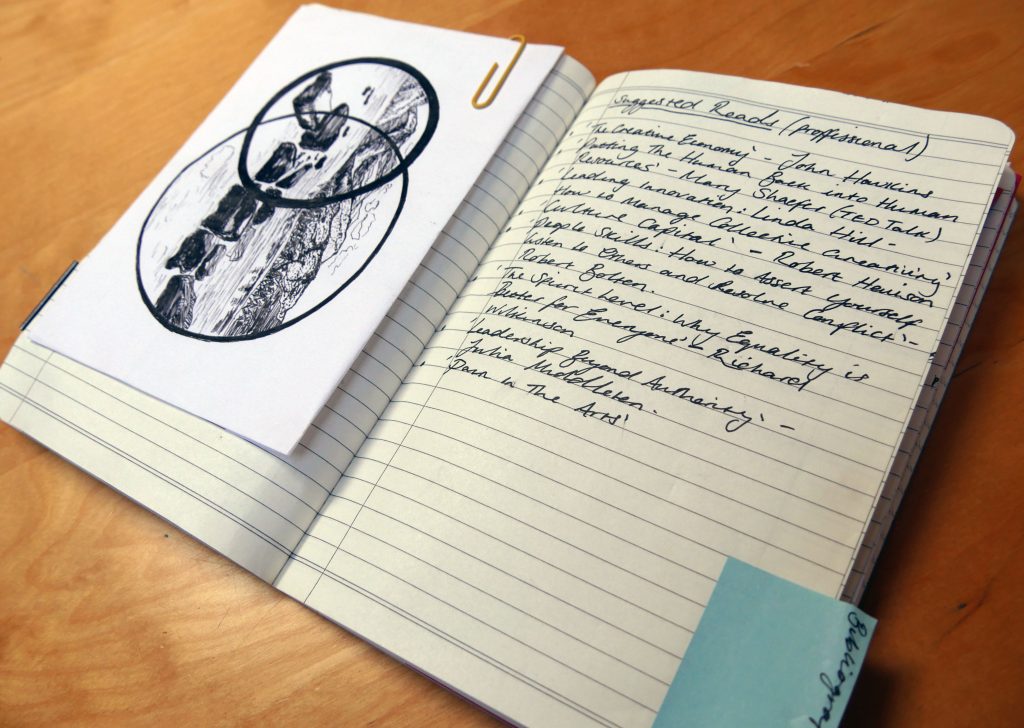Just over a year ago, I started on my professional journey at Writers’ Centre Norwich, a little blurry eyed and confused as to where exactly I could fit in the professional world. I still don’t entirely know the answer, but alongside some brilliant mentoring and support from my organisation, the reflective tool of creative professional journaling has been key in aiding to clarify what revs my professional engine, which of my skills and abilities enable it, and where I need refining.
When I first started in my position, my line manager suggested I note down what I have done weekly for the first few weeks – to keep track of my workload and what I was learning. My work diary took a very typical form, a few prompt questions on the week’s work in a small notebook: Key tasks and projects throughout the week? What have you learned? What have you struggled with? This format worked best early on as a tool of more coherent communication with my line managers about what I was doing day-to-day, and a clear document I could refer to in catch ups. It came in handy for those daunting work reviews and self-assessments, as I had a clear timeline of my development to refer back to.
As time went on, my journal took a more physically creative, and professionally philosophic tone. My role in operations with Writers Center Norwich requires an orderly approach, a keen eye for detail, and generally is not typically creative. In a very organic way, my work journal began to form into a slightly more tactile, visual outlet. It is a place to document inspiration, to express fears, or brainstorm creative solutions that work alongside the necessary utilitarian processes and procedures that predominantly govern how I work daily – inject a bit of Pinteresty pizazz into my spreadsheet filled work life.
Although I let my work journal grow into what it is quite naturally, there have been some specific key features or formats that have guided my entries. They can be categorised into four types of entry:
- Inspiration
The Andrew Lloyd Webber training programmes with Weston Jerwood Creative Bursaries, my work with Writers Center Norwich, the programme of discussion with my Mentor, and personal interests, have provided me with a lot of amazing opportunities to visit cultural events and organisations. I used my journal to document these visits, and any ideas that may have come from them. This also took form in a bibliography of relevant texts which I have either read or are planning to.
- Reflection
This is the most obvious one. I would use the space for regular generic entries reflecting on the week, as well as more directed reflections on specific events, meetings or general issues.
- Planning
A space to look forward to the near and far future. To plan specific events, work goals, or to look further ahead to a longer professional future.
- Questioning
A journal can be a place to ponder the larger questions faced in professional development. Alongside my mentoring sessions, I used my journal to begin considering questions like: What would you like to be remembered for over the next few years? What keeps you up at night regarding your position? What is your motivation for being in this role, and the arts in general?
Having a physical space, and dedicated regular time to summarise the week’s events became a cathartic mode of self-assessment and expression. It has become a way for me to see the art in being a facilitator or administrator, rather than an artist myself, which has been a great lesson to come to terms with. Keeping a work journal forces you to take a regular step back and assess yourself, and helps you to hold yourself accountable for your own professional growth. I highly recommend the process.
